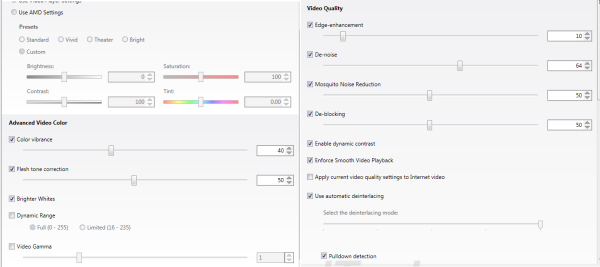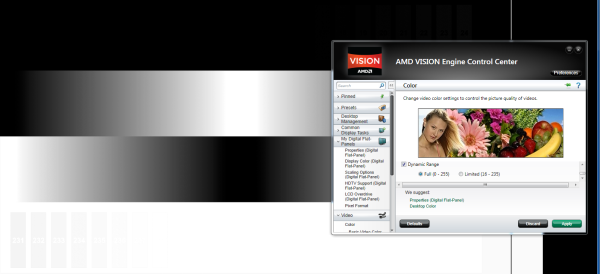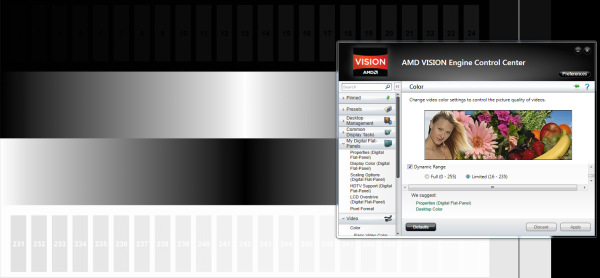AMD's Trinity : An HTPC Perspective
by Ganesh T S on September 27, 2012 11:00 AM ESTHTPC enthusiasts are often concerned about the quality of pictures output by the system. While this is a very subjective metric, we have been taking as much of an objective approach as possible. We have been using the HQV 2.0 benchmark in our HTPC reviews to identify the GPUs' video post processing capabilities. The HQV benchmarking procedure has been heavily promoted by AMD, but Intel also seems to be putting its weight behind that now.
The control panel for the Trinity GPU retains the host of options from earlier Catalyst releases. We used Catalyst 12.8 in our testing.
HQV scores need to be taken with a grain of salt. In particular, one must check the tests where the GPU lost out points. In case those tests don't reflect the reader's usage scenario, the handicap can probably be ignored. So, it is essential that the scores for each test be compared, rather than just the total value.
The HQV 2.0 test suite consists of 39 different streams divided into 4 different classes. For the Trinity HTPC, we used Cyberlink PowerDVD 12 with TrueTheater disabled and hardware acceleration enabled for playing back the HQV streams. The playback device was assigned scores for each, depending on how well it played the stream. Each test was repeated multiple times to ensure that the correct score was assigned. The scoring details are available in the testing guide from HQV.
Blu-rays are usually mastered very carefully. Any video post processing (other than deinterlacing) which needs to be done is handled before burning it in. In this context, we don't think it is a great idea to run the HQV benchmark videos off the disc. Instead, we play the streams after copying them over to the hard disk. How does the score compare to what was obtained by the Llano and Ivy Bridge at launch?
In the table below, we indicate the maximum score possible for each test, and how much each GPU was able to get. The HD4000 is from the Core i7-3770K with the Intel 8.15.10.2696 drivers. The AMD 6550D was tested with Catalyst 11.6 (driver version 8.862 RC1).
| HQV 2.0 Benchmark | ||||||
| Test Class | Chapter | Tests | Max. Score | AMD 6550D (Local file) | Intel HD4000 | AMD 7660D |
| Video Conversion | Video Resolution | Dial | 5 | 4 | 5 | 5 |
| Dial with Static Pattern | 5 | 5 | 5 | 5 | ||
| Gray Bars | 5 | 5 | 5 | 5 | ||
| Violin | 5 | 5 | 5 | 5 | ||
| Film Resolution | Stadium 2:2 | 5 | 5 | 5 | 5 | |
| Stadium 3:2 | 5 | 5 | 5 | 5 | ||
| Overlay On Film | Horizontal Text Scroll | 5 | 5 | 3 | 5 | |
| Vertical Text Scroll | 5 | 5 | 5 | 5 | ||
| Cadence Response Time | Transition to 3:2 Lock | 5 | 5 | 5 | 5 | |
| Transition to 2:2 Lock | 5 | 5 | 5 | 5 | ||
| Multi-Cadence | 2:2:2:4 24 FPS DVCam Video | 5 | 5 | 5 | 5 | |
| 2:3:3:2 24 FPS DVCam Video | 5 | 5 | 5 | 5 | ||
| 3:2:3:2:2 24 FPS Vari-Speed | 5 | 5 | 5 | 5 | ||
| 5:5 12 FPS Animation | 5 | 5 | 5 | 5 | ||
| 6:4 12 FPS Animation | 5 | 5 | 5 | 5 | ||
| 8:7 8 FPS Animation | 5 | 5 | 5 | 5 | ||
| Color Upsampling Errors | Interlace Chroma Problem (ICP) | 5 | 2 | 5 | 5 | |
| Chroma Upsampling Error (CUE) | 5 | 2 | 5 | 5 | ||
| Noise and Artifact Reduction | Random Noise | SailBoat | 5 | 5 | 5 | 5 |
| Flower | 5 | 5 | 5 | 5 | ||
| Sunrise | 5 | 5 | 5 | 5 | ||
| Harbour Night | 5 | 5 | 5 | 5 | ||
| Compression Artifacts | Scrolling Text | 5 | 3 | 5 | 5 | |
| Roller Coaster | 5 | 3 | 5 | 5 | ||
| Ferris Wheel | 5 | 3 | 5 | 5 | ||
| Bridge Traffic | 5 | 3 | 5 | 5 | ||
| Upscaled Compression Artifacts | Text Pattern | 5 | 3 | 3 | 3 | |
| Roller Coaster | 5 | 3 | 3 | 3 | ||
| Ferris Wheel | 5 | 3 | 3 | 3 | ||
| Bridge Traffic | 5 | 3 | 3 | 3 | ||
| Image Scaling and Enhancements | Scaling and Filtering | Luminance Frequency Bands | 5 | 5 | 5 | 5 |
| Chrominance Frequency Bands | 5 | 5 | 5 | 5 | ||
| Vanishing Text | 5 | 5 | 5 | 5 | ||
| Resolution Enhancement | Brook, Mountain, Flower, Hair, Wood | 15 | 15 | 15 | 15 | |
| Video Conversion | Contrast Enhancement | Theme Park | 5 | 5 | 5 | 5 |
| Driftwood | 5 | 5 | 5 | 5 | ||
| Beach at Dusk | 5 | 5 | 5 | 5 | ||
| White and Black Cats | 5 | 5 | 5 | 5 | ||
| Skin Tone Correction | Skin Tones | 10 | 7 | 7 | 7 | |
| Total Score | 210 | 184 | 197 | 199 | ||
We did some quick tests to ensure that all the post processing steps available for Blu-rays were also available for local files using MPC-HC's EVR renderer. AMD deserves kudos for being the only GPU vendor to get the local cadence detection (with respect to the shredding of overlay text) correct. In addition, they are the only ones to offer mosquito noise reduction as an option in addition the usual denoising setting. The chroma upsampling issue we noticed with the Llano is no longer an issue. With a score of 199, the 7660D with the Catalyst 12.8 drivers becomes the best performer on the HQV front. It is possible that the 7750's scores have also improved with these drivers, but we will take a look at that in another piece.
However, this doesn't mean that AMD's drivers are perfect. By default, the EVR / EVR-CP renderers rely on the drivers to supply the correct video levels to the display. As the screenshots below indicate, the meanings of full and limited seem to be interchanged.
Dynamic Range Set to Full for Video Playback (background)
Dynamic Range Set to Limited for Video Playback (background)
Setting the dynamic range to Limited (16-235) exposes black levels in the range 0-15 and 236-255, while setting it to Full (0-255) actually clips the color levels in the video in the background. This was one of the more obvious bugs that we encountered in our review process.













49 Comments
View All Comments
Beenthere - Thursday, September 27, 2012 - link
There is an appropriate CPU/APU model for every budget these days. Virtually any current model APU/CPU will perform just fine for 98% of consumers. Most consumers buy what fits their needs and budget, not the over priced, over hyped top-of-the-line models.AMDs new Trinity APUs and Vishera desktop FX processors offer more performance for less, which is good for consumers.
silverblue - Thursday, September 27, 2012 - link
We don't know about Vishera, not yet anyway. We don't know what the improvements over Bulldozer will yield as a whole, only what a couple of benchmarks showed in a brief Toms comparison between Trinity and Zambezi. There are plenty of scenarios to consider.Beenthere - Thursday, September 27, 2012 - link
Yes some of us do know the results... Comparing Trintiy to Vishera is incorrect. Vishera is to be compared to Zambezi.AMD has hit their projected 10-15% gains for Vishera compared to Zambezi. Some people already know the results but the NDA doesn't expire for a few weeks so they can't print them yet. Most folks will be happy with Vishera except the haters.
silverblue - Thursday, September 27, 2012 - link
I'd find it hard to believe you were personally under NDA (please prove me wrong). I also believe the gains were per clock, which should theoretically, given the assumption you stated, result in a slightly larger performance gap between the 8150 and the 8350 as the latter has a higher base clock and is more likely to hit max turbo speed.Like I said though, two benchmarks in the public domain aren't gospel, regardless of whether we're comparing Vishera OR Trinity to Zambezi. Remember that L3 cache doesn't always help, but when it does, the gains can be significant, meaning the A10-5800K could occasionally be outperformed by a similarly clocked 41x0 CPU, but the flip side is that it could occasionally perform on par with a similarly clocked 43x0 CPU.
Death666Angel - Thursday, September 27, 2012 - link
"AMD was a little late in getting to the CPU - GPU party. Their first endeavour, the Llano APU"Aren't Zacate and Ontario APUs? They were released in 01/2011, half a year before Llano. Or aren't you counting low power APUs? :)
Thanks for the article!
Death666Angel - Thursday, September 27, 2012 - link
Mea culpa, didn't read the comments before posting my own. :) Disregard.EnzoFX - Thursday, September 27, 2012 - link
What's the big deal with 4k at THIS moment? There are no 4k tv's out are there? By the time they're out, or by the time they're actually affordable by a decent amount of consumers, we would have several generations of new apu's.Denithor - Tuesday, October 2, 2012 - link
http://www.lg.com/us/tvs/lg-84LM9600-led-tvAllio - Thursday, September 27, 2012 - link
These HTPC-perspective articles are consistently some of the most useful and interesting content that AT puts up. As far as I can tell, there really aren't any other tech sites that delve this deep into this kind of functionality - most reviews settle for playing a 1080p Bluray and posting a screenshot of the CPU usage in task manager. While it may only be a relatively small audience for who this stuff is relevant, we are a very interested audience, and I personally appreciate every detail and statistic included. Thanks Ganesh!wharris1 - Thursday, September 27, 2012 - link
At this point, it seems 4k is more marketing hype. I'll link this article: http://reviews.cnet.com/8301-33199_7-57491766-221/...For the typical anandtech readers (probably much more technically gifted than me) I also recall reading a similar article/post on avsforums explaining that for any display size <~100 inches, the 4k standard is hard to justify. Also, while I know that future proofing is sound, there is very little content or ability to play back said content at that resolution. As a previous poster mentioned, by the time 4k becomes a standard, the current platforms will seem antiquated. Anyway, Anandtech is the best tech site around by far; read it every morning.